What is it?
A primer is a liquid mixture that is applied to surfaces (walls, floors, ceilings) before finishing: applying paints and varnishes, wallpapering, facing (puttying, applying plaster or mastics).
Primers are aqueous solutions (dispersions) of polymers and auxiliary substances. About 20-30% of their mass is synthetic resins, 60-80% – solvents, 2-5% – specialized agents. Some primers contain polyethylene (plastic), which strengthens the structure of the coating.

Why do you need a primer?
Primers are used at the initial stages of finishing (before painting, plastering, wallpapering) and, depending on the composition, perform different functions:
- enhance the adhesion of finishing materials to the base;
- level the surface, ensuring uniform application of paints, plaster, wallpaper;
- neutralize the color of stains;
- bind and strengthen loose surfaces;
- increase the resistance of the base to mechanical stress;
- seal pores and cracks, improving thermal insulation;
- help save paint and varnish mixtures used in finishing.
Specialized primers for walls have been developed that have special qualities. For example, some primer compositions increase moisture resistance, prevent corrosion, and provide antimicrobial properties of surfaces.
What types are there?
There are several classifications of primers applied to walls before finishing: painting, plastering, wallpapering. First of all, they are grouped by composition, degree of penetration, and basic properties.
By composition
Primers for walls are usually classified by the composition of chemical components that affect the basic properties of the formed layer. The following types are distinguished:
- Acrylic, or water-based. The scope of application of such primers is wide: they are applied to metal, wood, and mineral surfaces. As a rule, they are classified as deep penetration primers. They improve absorption capacity, fill small pores and cracks in the base. The main advantages are ease of priming and high drying speed. Acrylic compounds come in 2 types: strengthening and penetrating. The former bind and compact the surface particles of the material, while the latter create a layer up to 10 cm deep.
- Alkyd. They provide strength to wooden and metal wall surfaces. They contain special agent substances that suppress the development of microorganisms and corrosion. These are covering and elastic mixtures that adhere well to the surface.
- Glyphthalic. They belong to the category of alkyd primers: they are based on glyphthalic resins obtained by polymerizing alkyds. They are used as a protective coating for metal surfaces. They can be added to any paints (except organosilicon paints). They dry quickly and release a small amount of toxins.
- Polystyrene. Such primers are applied to treated wooden wall surfaces, forming a protective layer. They dry quickly, forming a moisture (water)-resistant and highly durable protective layer. They are intended only for exterior finishing works, since their chemical profile of polystyrene primers includes toxic substances.
- Phenolic. They are made on the basis of modified phenol-formaldehyde resin, form a hard and elastic coating that repels water. They are used to protect metal surfaces. They are easy to apply and dry quickly.
- Polyvinyl acetate. They are most often used for priming concrete, metal and wooden walls, giving them shine. They are also applied to pre-plastered surfaces. They dry extremely quickly (within 30 minutes). They are used only in combination with polyvinyl acetate paints.
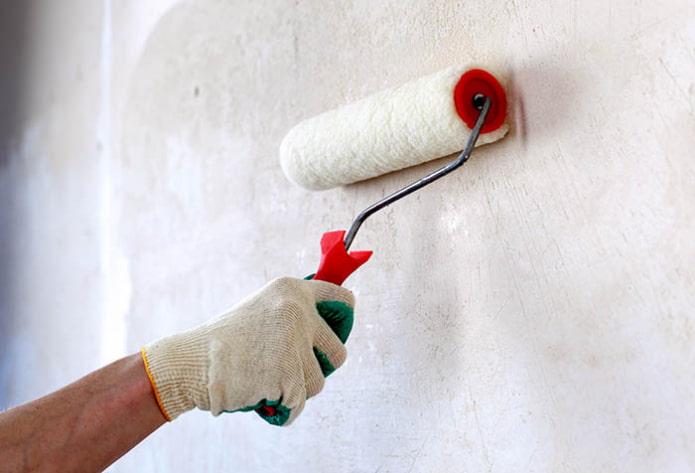
By penetration degree
Primers for walls are also distinguished by the degree of penetration into the structure of the base material:
- Deep penetration primers. These are aqueous solutions of polymers that can penetrate deep into porous surfaces, bind and strengthen them. Apply no more than 2 layers of solution, otherwise there is a risk of “over-priming”. In addition, when priming, it is necessary to provide conditions and time for complete drying, since polymers firmly adhere to materials only in the absence of moisture (water).
- Universal. They are used during finishing works to level and reduce the degree of moisture absorption (water absorption) of walls. As a rule, they do not penetrate into pores, but form surface films. Such primers have a lower consumption and dry faster.
A special primer called betonokontakt is worth mentioning separately. This is a special-purpose composition that is used to increase the adhesion of very smooth surfaces. Betonokontakt contains granular quartz sand, which provides roughness. Any finishing materials adhere well to it.
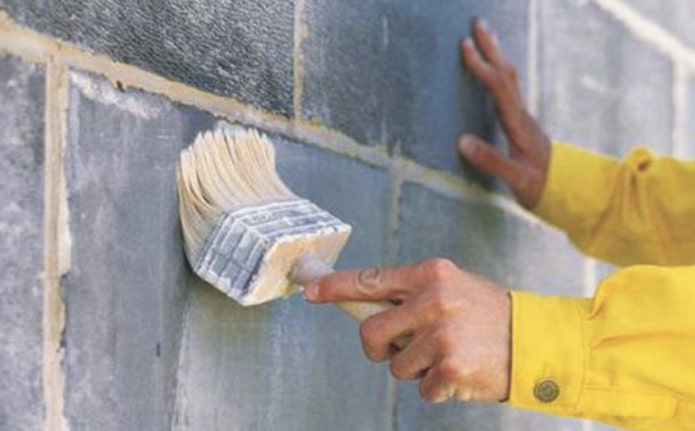
By properties
There are specialized primers for finishing walls, which in addition to basic qualities have auxiliary properties. Such compositions include:
- Moisture-proof. Provide waterproofing of walls, floors, ceilings and are used in rooms with high humidity. They are made on the basis of polymers that penetrate the surface structure and after drying form a water-repellent crystalline lattice. They are applied mainly to porous materials.
- Anticorrosion. Contain special corrosion inhibitors that prevent oxidation of metals in the presence of moisture. Provide high adhesion (bondage) and resistance of the base to temperature changes.
- Antimicrobial (anti-mold). Saturated with antiseptic substances that prevent the development of pathogenic microorganisms. As a rule, they belong to the category of deep penetration primers and are applied to any porous surfaces. Such mixtures must be applied before gluing wallpaper and applying plaster.
- Heat-resistant, or fire-resistant. They are applied to household and industrial products that are regularly exposed to excess heat. Most types of heat-resistant primer mixtures retain their basic properties at temperatures of no more than +600°C. There are also primers that can withstand temperatures up to +3000°C.
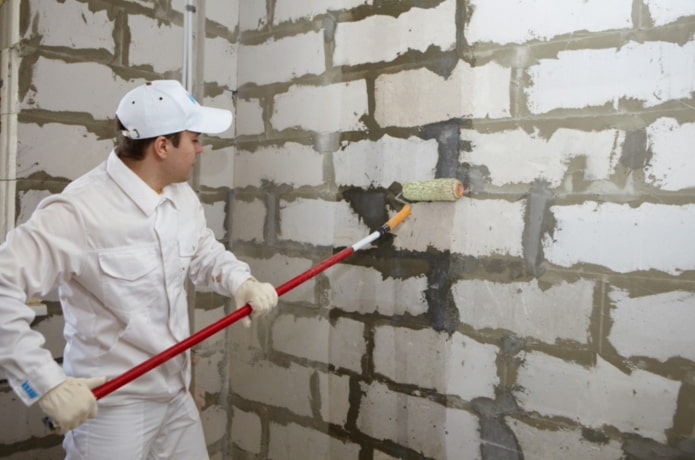
What is the consumption?
The average consumption of the primer (solution or concrete contact) is indicated by the manufacturer on the packaging. However, this figure may vary depending on several factors:
- The base material (structure) of the walls. Consumption greatly depends on the porosity and strength of the base. The higher its density, the less primer will be required.
- The type of primer. The chemical composition determines the consumption: resinous substances in the base are characterized by good hiding power and form a thick layer.
- The method of applying the primer before finishing the walls. When using a sprayer, a smaller volume of the mixture is consumed than when working with a roller or brush.
- The number of base layers. The more of them, the higher the consumption.
- The temperature and humidity indicators of the environment. A smaller volume of the priming mixture is consumed inside a warm and dry room.
On average, 80-150 g of universal (acrylic) primer is required per 1 m2 of metal surface. If the base is made of wood, brick, concrete, then the consumption will increase. It is highest in relation to concrete contact.

How long does it take to dry?
The drying speed of the primer depends on its composition, the degree of penetration (deep or normal, concrete contact) and the thickness of the applied layer. As a rule, universal mixtures intended for dense surfaces, such as metal, are subject to rapid dehydration.
Thus, polyvinyl acetate primers dry in 30 minutes, and glyphthalic ones – in 8 hours. Deep penetration primers based on polymer resins take much longer to dry, on average within 24 hours.
The exact drying time is indicated by the manufacturer on the packaging.
What surfaces need to be primed and their features?
It is recommended to prime any base, regardless of whether further wall treatment is planned (painting, applying decorative plaster and tiles, wallpapering). The following surfaces must be covered with a protective layer:
- Metal. They are very dense, often exposed to excess heat. Therefore, they are covered with compounds with anti-corrosion and heat-protective properties.
- Concrete-based. Such walls are smooth, so they do not adhere well to finishing materials. To improve the adhesive ability of wallpaper, primers are used.
- Wood-based. Such surfaces are always covered with a primer that ensures the formation of a film to increase moisture resistance and high adhesion (bondage). The composition of the base mixtures used also includes substances that prevent the development of mold.
- Based on plasterboard. Primers help to strengthen and level such walls. In addition, they provide waterproofing and excellent adhesion when applying paint, glue or decorative plaster and tiles, gluing wallpaper on plasterboard surfaces.
- Based on brick. Since they are very porous, deep penetration polymer primers are used.
Primer should not be used only on previously painted surfaces that are in good condition (the upper layers do not peel off or crack).
It should also be taken into account that most modern high-quality paints for external and internal work are self-priming. They have composition characteristics that allow them to adhere to most previously painted surfaces without the need for priming.
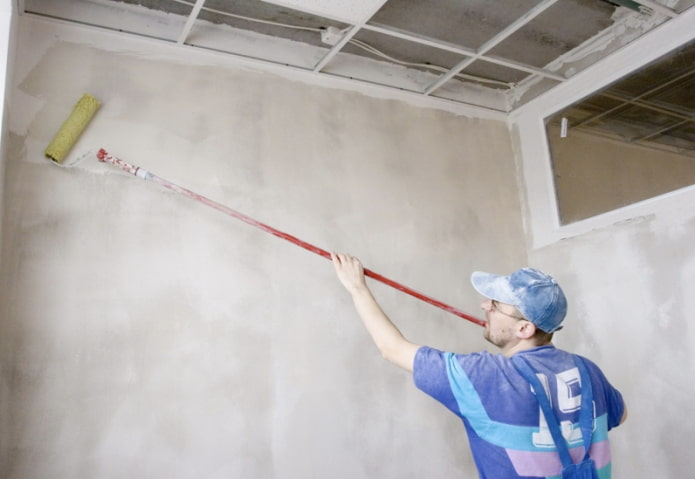
What to consider when choosing?
When choosing a primer for treating walls and other surfaces, you should focus on the following characteristics:
- type (structure) of the base;
- chemical composition;
- properties of the base mixture;
- penetration (deep or normal);
- base color;
- reputation of the manufacturer.
You should also understand what the next stages of processing are. For example, before gluing wallpaper or applying decorative plaster and tiles, mainly acrylic deep penetration mixtures are applied, and before painting metal – universal (sometimes heat-resistant).
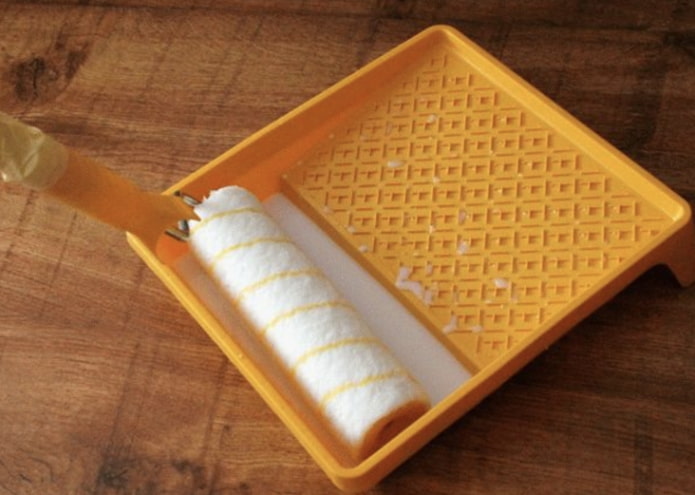
Tips for applying primer
Priming walls for wallpaper or painting is not a difficult task. However, it requires understanding some nuances and strictly following the sequence of work.
Stages of priming:
- Preparing the work area. Remove furniture and cover the floor with tarpaulin. Collect the necessary tools and materials.
- Preparing the surface for priming. Remove tiles, wallpaper, paint, and glue layer. The bases are carefully examined, identifying and eliminating defects and roughness. For example, large cracks are sealed with putty, then sanded. Peeling paint, a layer of glue or putty, peeling plaster and roughness are processed with fine-grained sandpaper. They try to even out the color, getting rid of stains.
- Removing dirt. The walls are completely washed with a soap solution, since a clean surface adheres better to finishing materials.
- Isolation of areas not intended for processing. They must be completely covered using masking tape and polyethylene film.
- Priming. The composition is thoroughly mixed and poured into a special tray. Using a roller or brush, apply it sequentially to the walls. Betonokontakt is applied with a spatula or roller.
- Drying. Wait for penetration and the moment when the primer is completely dehydrated and forms a strong film. Only then do they start painting, applying decorative plaster, and gluing wallpaper.
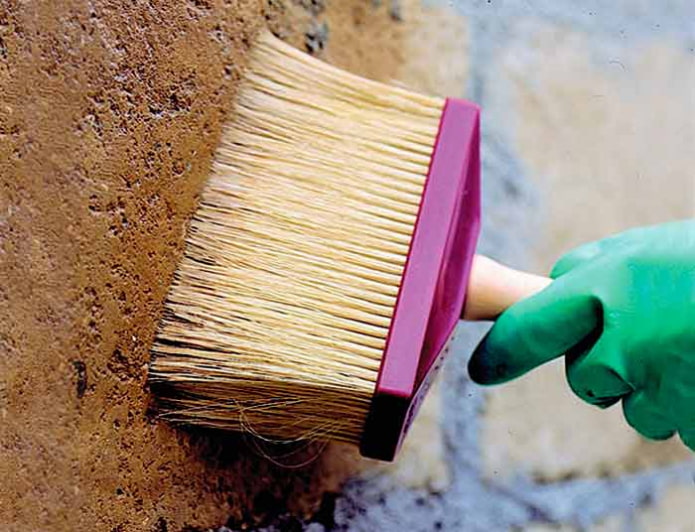
If these recommendations and conditions are followed (absence of moisture and normal temperature), the protective coating of the walls will be of high quality, as a result of which the paint, adhesive layer, and plaster will lay down correctly.
Now reading:
- Your Comprehensive Guide to Chevrolet Pre-Owned Vehicles
- Ceiling Decor Ideas: 50 Stylish Photos for Inspiration and Design.
- How to Build an Extension to Your House? – Step-by-Step Guide and Ideas (23 Photos)
- 10 ideas for brick barbecues for delicious shashlik and aesthetic design.
- 80 Inspiring Blue Wallpaper Ideas for Bedroom, Kitchen and Other Rooms.